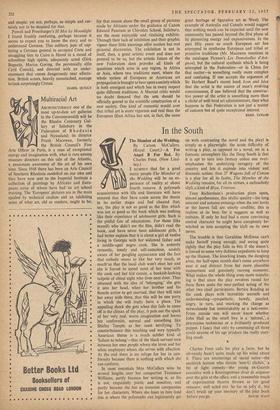Multiracial Art
ARCHITECTURALLY one of the most up-to-date art galleries in the Commonwealth will be the Rhodes Centenary Gal- lery at Salisbury in the Federation of R h odesia and Nyasaland; its director Frank Macewan, formerly the British Council's Fine Arts Officer in Paris, is a man of exceptional energy and imagination with, what is rare among museum directors on this side of the Atlantic, a passionate awareness of the art of his own time. Since 1948 there has been an Arts Council of Southern Rhodesia modelled on our own and they have now sent to the Imperial Institute a collection of paintings by Africans and Euro- peans some of whom have had an art school training. The 'European' pictures are in the main spoiled by technical caution and an inhibiting sense of what art, old or modern, ought to be;
for that reason alone the small group of pictures made by Africans under the guidance of Canon Edward Paterson at Chirodzo School, Salisbury, are the most enjoyable and vitalising exhibits. Through their lack of inhibition and their graphic vigour these little paintings offer modest but real pictorial discoveries. The exhibition is not in itself, then, a great artistic event and does not pretend to be so, but the artistic future of the new Federation does provoke all kinds of questions which arise in any region, in Africa or Asia, where two traditions meet, where the whole system of European or American art propagation is brought to bear upon a society which is both emergent and which has in every respect quite different traditions. A Marxist critic would no doubt demand that the arts should be officially geared to the scientific construction of a new society. One kind of romantic would aver that tribal art is more vigorous and real than the European (East Africa has not, in fact, the same great heritage of figurative art as West). The example of Australia and Canada would suggest that nothing much can be expected until the new community has passed beyond the first phase of its pioneering energy and expansiveness. In the past fifty years so much European art has attempted to synthesise European and tribal or primitive traditions (Mr. Macewan mentions in the catalogue Picasso's Les Demoiselles d'A vi- gnon), but the cultural synthesis which is being attempted in the Federation—or in China for that matter—is something vastly more complex and confusing. If one accepts the argument of Sir Herbert Read's recent book Icon and Idea that the artist is the source of man's evolving consciousness, if one believed that the construc- tive power of the artist is something more than a cliché of well-bred art administrators, then what happens in this Federation is not just a matter of concern but of quite exceptional interest.
BASIL TAYLOR


































 Previous page
Previous page